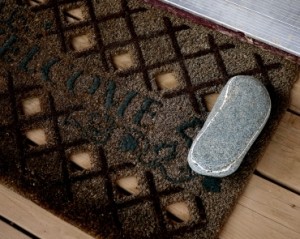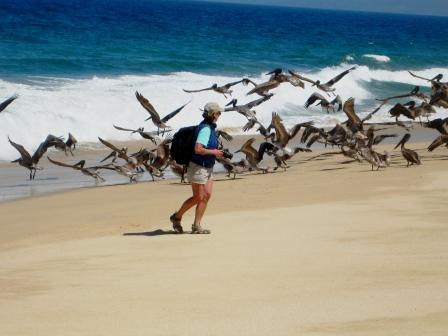Baja California Travelblog
Turtles, Whales, Dolphins, Pelicans, Clams, Gringos
BienvenidosThere was a strange grey stone shaped and lined like a size medium Indian moccasin, right foot, the foot you extend first in yoga, Buddha foot, scout foot. We (my traveling partner Pat and I) first saw it on the six-mile walk up the shore below Todos Santos in south Baja California. It had been tossed high on the otherwise clean dry sand by the explosive surf. We kept walking in the cool wind – it was April – entertained by heavy grey pelicans gliding impossibly just inches above the sand like hovercraft and by hermit crabs of all sizes flashing to their safe houses. We ate nachos and drank margaritas and watched the surfers from a table at the gringo-owned Los Cerritos Surf and Beach Club (the club is private, the beach is public). On the way home, there it was again, the unlikely Buddha foot. We took it, packed it, flew it a thousand miles. It rests now on the right outside my door as if I have a one-foot guest who knows the Way.
So going in and going out I think of the Baja guest house and the numming drumming of the waves and the long stairway dropping to the shore and our six-mile walks on the sand and the pelicans and gulls. Pat reserved it on the internet. We flew to the cape and rented a car and found the address on a high wall in a gated community. Our hosts were an enterprising couple who had designed and built their little semitropical paradise themselves. Günter would go to the beach with a casting rod and come back with a string of yellowtail croakers and clean them and pop them on the outdoor grill and Melanie would make salad from their garden.
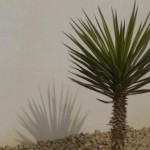 One evening they invited us to a “sundowner” gathering of neighbors, mostly Americans. There was some talk of well planned burglaries and the risk of accusing the burglars and police corruption. An American supplier of some patented hardware made in China was building a hacienda-style getaway down the shore with a tile-roofed tower overlooking everything. It was going to cost about $3 million and was designed by an architect creative enough to avoid duplicating the California mission style (as did the designer of the mansion on the hill above Los Cerritos). The manufactuer was happy with his construction crew of about 20 men who lived on the building site. His handsome son and his son’s tanned girlfriend were happy with surfing at Los Cabos.
One evening they invited us to a “sundowner” gathering of neighbors, mostly Americans. There was some talk of well planned burglaries and the risk of accusing the burglars and police corruption. An American supplier of some patented hardware made in China was building a hacienda-style getaway down the shore with a tile-roofed tower overlooking everything. It was going to cost about $3 million and was designed by an architect creative enough to avoid duplicating the California mission style (as did the designer of the mansion on the hill above Los Cerritos). The manufactuer was happy with his construction crew of about 20 men who lived on the building site. His handsome son and his son’s tanned girlfriend were happy with surfing at Los Cabos.
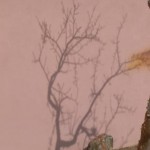 In a corner against a wall a diminutive couple watched shyly. They did not speak fluent English. She did housework in the enclave and was helping with the party. Her husband minded their small store in Todos Santos where they sold handicrafts from Michoacán, their home. They were not happy about the way business was going. It was the spring of the swine flu, and although no cases had been reported in Baja California Sur, the media scare combined with the drug war had depressed the tourist trade. (Three thousand rooms were said to be vacant in Cabo San Lucas, where we saw restaurants and shops almost empty in the shadows of incomplete shells of hotels.)
In a corner against a wall a diminutive couple watched shyly. They did not speak fluent English. She did housework in the enclave and was helping with the party. Her husband minded their small store in Todos Santos where they sold handicrafts from Michoacán, their home. They were not happy about the way business was going. It was the spring of the swine flu, and although no cases had been reported in Baja California Sur, the media scare combined with the drug war had depressed the tourist trade. (Three thousand rooms were said to be vacant in Cabo San Lucas, where we saw restaurants and shops almost empty in the shadows of incomplete shells of hotels.)
Next time we were in Todos Santos we stopped at the couple’s tiny shop across from the church. They were sitting in the dark and turned on the lights when we came by. We bought some things and wished them luck. They were lovely. In one of the art galleries we were detained by the work of Diaz Castro of La Paz and wished we could buy the one called “El Reposo” of a man asleep under a white hat. I saw emptiness in the white disk. Artists will save Todos Santos from the time-share condo soldiers whose ads support an artless English weekly called The Gringo News.
At lunch in a well managed café across the street from the Hotel California I began to reminisce about our first trip here. We drove down through the deserts in a 1979 Volkswagen bus and I wanted to believe that the Hotel California was where Don Henley wrote the song of the same name. It was a nicer time, and the border towns were no big risk. . . .
Baja By Retro
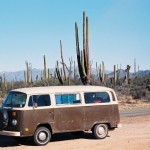 On that January day we crossed the border at San Luis on the Colorado River and drove across the top of Mexico and turned left at Tecate. My 1979 VW bus was undoubtedly the oldest vehicle on the incredible highway over the Sierra Juraez. Forget the old-car stereotype about Mexico! The new SUV’s of the border middle class streamed by us constantly.
On that January day we crossed the border at San Luis on the Colorado River and drove across the top of Mexico and turned left at Tecate. My 1979 VW bus was undoubtedly the oldest vehicle on the incredible highway over the Sierra Juraez. Forget the old-car stereotype about Mexico! The new SUV’s of the border middle class streamed by us constantly.
We drove down through a wine and olive valley, spent the night at a campground where oranges were freezing on the trees, then ambled on to Bahia de Los Angeles, a still undeveloped bay protected by the Isla Angel Guardia.
John Steinbeck wrote a book I never read called “The Sea of Cortez” in the 1940s. He based it on a long stay at Bahia de LA, and he is still remembered in the guide books as the one who saw the fishery disaster coming.
It must have been a pretty little village. We imagined the fishermen, the boats, the motorless quiet. Now there is a sterility that speaks of global industry. The Japanese and others dragged the Sea of Cortez clean, and only some of the species of marine life are coming back.
We took a long walk in the wind (the cold streaming down the channel between the isla and mainland from U.S. America) along the curving shore north of the village. It got us away from the good ol boys at Daggetts campground standing and jawing and beer drinking and looking at their rigs. These guys are OK, but they get loud, especially when their dishes are tuned to the NFL. They fish, sport fish, and thats fine. Sport fishing is kinda natural, as subsistence fishing must have been. There’s a balance there.
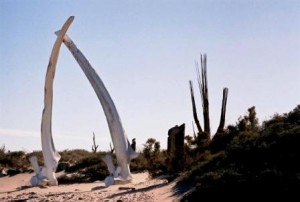
Anyway, we walked two or three miles in the wind from the north– so forceful the sea looked like a great river flowing south. Every 100 feet or so was a lot line — the entire shore has been subdivided and sold. There was a new health spa under construction on a combined group of lots. There was a nice Santa Fe style house with a whale-rib gate on another. Most were haphazardly developed with palapas (what are called ramadas in NM) and mobile units.
We saw gulls and plovers and pelicans and a few other birds and a sign that begged people not to drive their ATVs along the dune band where snowy plovers and least-terns try to lay their eggs. But we did not see indications of much marine life. Maybe it was just the weather, plus my over-read imagination, but it was a sterile walk along a cold shore. And I blamed the industrial fishing operations that Steinbeck foresaw.
Later I walked south of Daggett’s again to see the turtles — remnants of marine life. A project headed by Antonio Resendiz accepts turtles from fishermen who drag them up in their nets. Antonio nurses the rare Loggerhead sea turtles in concrete tubs until they are healthy and, in some cases, mature enough to be tagged and let go in the sea.
A big moment for Antonio was some five years ago when a biologist from Arizona drove down to tell him about an email communication. A biologist in Japan had been given a Loggerhead turtle with a tag. Some correspondence proved that the turtle was one Resendiz had released from the Baja about 16 months earlier. The female must have swum 6,000 miles across the Pacific.
Further research corroborated the idea that these rare turtles born in the West Pacific, on the shores of China and Japan, swim to the Baja to eat crabs and such things, then swim back. The briefs I read on Antonio’s bulletin board gave no explanation for this strange migration.
I watched the turtles for a while, and I think they watched me. They were very slow in the pool and patient. But they have a lot of time. Free of industrial trauma they can live 400 years or so.
Sitting near the turtles and reading in the sun by a motorcycle and a small tent was a young man from Canada. He said he was going to volunteer for Antonio for a week, then move on. He said he once had a job in the mountain bike business but he sold everything and hit the road. All his possessions were with him. He said he was going to Argentina, where he would meet his girlfriend, who also had sold everything and bought a motorcycle (although she was freighting it to Argentina).
I told him I admired him, that I could understand what he was doing. The world is alive with strange migrations.
Walking back I saw a seagull rise with something in its beak, then drop it on the rocks, then fly down, then rise with it again, then drop it on the rocks. The second time cracked the clam, or whatever it was, and the gull was pecking expertly and eating.
A Whale of a Tale
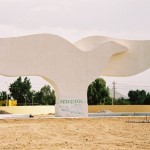 The tourist industry in Baja California uses whale imagery in the way that Arizona uses the saguaro cactus figure. In La Paz the city logo is a wonderful drawing that combines a whale’s tail and a dove (La Paz means peace). We saw the gray whales at Gerrero Negro, where we joined a tour in a 25-foot boat with an outboard motor. At first they were distant distortions in the water. Then we began to see the distortions had tails, those famous tails that fly like flags when the whales dive. They were far enough away not to splash us, but I recalled stories of great whales in the deadly days flicking boats full of harpooners into splinters.
The tourist industry in Baja California uses whale imagery in the way that Arizona uses the saguaro cactus figure. In La Paz the city logo is a wonderful drawing that combines a whale’s tail and a dove (La Paz means peace). We saw the gray whales at Gerrero Negro, where we joined a tour in a 25-foot boat with an outboard motor. At first they were distant distortions in the water. Then we began to see the distortions had tails, those famous tails that fly like flags when the whales dive. They were far enough away not to splash us, but I recalled stories of great whales in the deadly days flicking boats full of harpooners into splinters.
Then we became aware of their spouting. The great gushes of air and fountains of spray would be the first signs, and we would turn our heads toward the sound and see the whale blow, then rise. But what I had never realized (stupidly) was that the spouting is part of the whale’s breath cycle. They hit the surface, blow, then inhale. The sound of the spout was an expectable hiss and splash. But the sound of the inhalation was something I had never imagined.. It’s a great hollow sound, so deep and round and full. To be close enough to hear them breathe! That made them real.
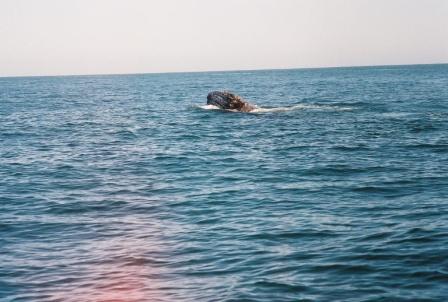 In fact, it sorta made them human. I thought of my yogini friends at Yogasource in Santa Fe trying to teach me breathing and consciousness of breath. It occurred to me that whales certainly must be the most yogic natural breathers on earth. They have to be aware of each exhale and inhale. They have to time their breaths to their surfacing. I wondered if they had a calculating intelligence that told them how far down they could go before having to surface and breathe. There is so much we don’t know about the other mammals.
In fact, it sorta made them human. I thought of my yogini friends at Yogasource in Santa Fe trying to teach me breathing and consciousness of breath. It occurred to me that whales certainly must be the most yogic natural breathers on earth. They have to be aware of each exhale and inhale. They have to time their breaths to their surfacing. I wondered if they had a calculating intelligence that told them how far down they could go before having to surface and breathe. There is so much we don’t know about the other mammals.
Then toward the end of the trip we came upon a pair of them mating. They were rolling and bounding and bobbing and spouting often. Two flippers would be standing off the surface like sails as two whales rolled belly to belly (I assumed). Pretty soon the splashing and spouting and flashes of whale disappeared. Our boatman said it takes them about 20 minutes. Somebody suggested we were seeing “whale porn,” but of course porn is fiction and this was not. On the contrary, with gray whales endangered, it is life itself. At one time there were only 2,000 of them. Now, our guide said, there are 25,000 gray whales on earth.
They migrate annually from the Arctic to these warm lagoons on the Baja, where they breed and give birth (gestation is a year). The guide said one attraction of the lagoons besides temperature and food supply is the salinity. He said the baby whales, which weigh a ton at birth, float easier in the lagoons because of the high salt content. The newborns can’t swim and must be supported on the surface. The guide told an amazing story of porpoises, which also live in these waters, swimming under baby whales and pushing them to the surface when they were in trouble. I wonder how natural selection produced the porpoise as well as the shark. As Blake said of the tiger, did he who made the lamb make thee?
Welcome To The Hotel California
 The Hotel California was being a lovely place at least on its lovely face in the middle of Todos Santos on the Pacific side of Baja California Sur. In the bar next door they keep playing the Eagles.
The Hotel California was being a lovely place at least on its lovely face in the middle of Todos Santos on the Pacific side of Baja California Sur. In the bar next door they keep playing the Eagles.
“Welcome to the Hotel California. Such a lovely place. . .”
We did not check in because, well, “You can check out any time, but you can never leave.” Instead we stayed at the Todos Santos Inn, a restored brick manor, hacienda style, on a hill. Craig and John, the owners, run a fine place by any standard anywhere. And every room is individual, non-repeatable. Which brings me to the subject of art.
Todos Santos is an artist’s community. It has a dozen or more galleries. The literature at the Todos Santos Inn suggests that the town is “the new Santa Fe.” And indeed the best restaurant in town, Italian, is called the Santa Fe. The owners, an American woman and an Italian man, have R.C. Gorman posters in the entry.
I was not aware of the need for a new Santa Fe until we came here. But seeing the affordability and artfulness of the place, I thought how Santa Fe in the old days was like this. The Cinco Pintores built beautiful homes using indigenous materials in the local style. The contributed to the community in their own Gringo way, and as far as I know there was harmony. Now Santa Fe is too expensive for artful people of good taste.
But what is art? The essential thing is it is original. Not repeatable. Every house in old Santa Fe was an original. Every painting was. Then in the 1960’s craftspeople learned how to make new frame houses look like adobe houses. Franchises moved in. And so forth.
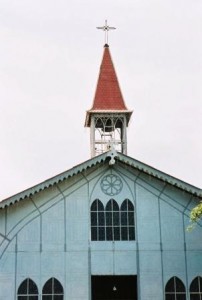
In the town of Santa Rosalia we saw something that to me must have been the first experiment with industrialized architecture. It was a franchise church, sorta. In the 1890’s Gustave Eiffel, using the same structural principles and steel materials he used for his now famous tower, designed a church. It won a prize at the Paris Exposition.
It was a portable Catholic church with exposed steel supports in Gothic forms and stamped sheet metal walls. It was designed for the tropics. The French still had equatorial colonies, including those in Indochine. The idea was to send these packaged churches everywhere, spreading the faith.
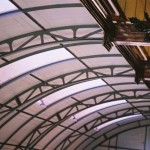 Only one was ever fabricated, the one for the Exposition. Then in 1897 a copper company executive saw it disassembled in a warehouse and bought it and sent it to the company town in Baja California, where it stands today. The doors are open, and the people of Santa Rosalia still worship there, in the square just down from the French bakery. The copper refinery is wasting away on the waterfront where for a while they were living it up in the Hotel California.
Only one was ever fabricated, the one for the Exposition. Then in 1897 a copper company executive saw it disassembled in a warehouse and bought it and sent it to the company town in Baja California, where it stands today. The doors are open, and the people of Santa Rosalia still worship there, in the square just down from the French bakery. The copper refinery is wasting away on the waterfront where for a while they were living it up in the Hotel California.
“You can check out any time you want, but you can never leave.”
The Dolphins
I filed a couple of sad commentaries about marine life. Here is a happy one.
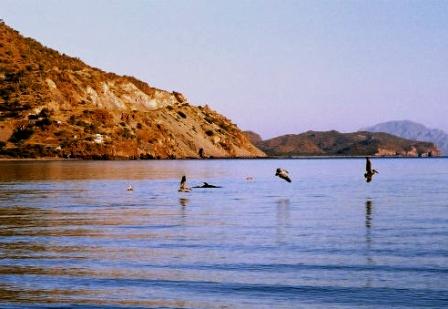
We were living on a free beach just north of the failed resort of Puerto Escondido. One morning the sea was unusually calm, and as we walked along the beach we noticed a great disturbance. Black forms rose and fell. Fins were flying everywhere. A group of dolphins were feeding!
They were like a flock of birds, gathering and turning and pursuing. They were systematically driving fish toward the smal cove at the south end of the beach. Pelicans were following, all excited and clunky. When a fish flew into the air to avoid the dophins, often a pelican would catch him in the air.
I suppose there were about a dozen dolphins, and as always they seemed to be having fun. Then they moved on, southward to other coves. People who have been staying on the beach in their RVs for several weeks or months said the dolphins come around every week or so, when the sea is calm.
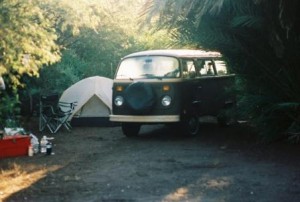 The next bay is Escondido, and we visited it to buy some coffee at a little store. Sometime in the last decade a huge resort was laid out here by the government tourist agency. Several blocks of wide, well lighted streets were built, along with a docking canal and a malecon, or seaside promenade. All are decaying in the salt air. Somebody began a hotel, then stopped. The rebar rusts away.
The next bay is Escondido, and we visited it to buy some coffee at a little store. Sometime in the last decade a huge resort was laid out here by the government tourist agency. Several blocks of wide, well lighted streets were built, along with a docking canal and a malecon, or seaside promenade. All are decaying in the salt air. Somebody began a hotel, then stopped. The rebar rusts away.
On the road to the great future resort, a small business serving RV people is developing into a resort all its own. There is a swimming pool now, although dry, and a restaurant. I commented this is the way things develop in America. You start small and see what happens. You distrust big plans, particularly if they are issued by government.
Journalism forbids national stereotyping, but since there are no editors on the Internet, I have some stereotypes.
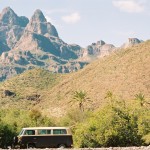 The southern half of the beach, Juncalito, is in a national park, I was told, and there is a sign at the presumed line that says No Camping. Nobody camps beyond the sign, except Americans, according to the license plates. I saw four American vehicles there, and no others, this morning. That part of the beach is nicer. It also is closer to the cove where the dolphins drive the fish. Americans are eco minded, I suppose.
The southern half of the beach, Juncalito, is in a national park, I was told, and there is a sign at the presumed line that says No Camping. Nobody camps beyond the sign, except Americans, according to the license plates. I saw four American vehicles there, and no others, this morning. That part of the beach is nicer. It also is closer to the cove where the dolphins drive the fish. Americans are eco minded, I suppose.
Most of the people elsewhere on the beach are Canadians. The Canadians tell the story how some of them every year clean up the beach, bagging trash and taking it to the nearest town, Loreto. They say the trash is left by Mexicans who like to party here during the big Easter vacation. So much for stereotypes.
One resident of the beach, a handsome Bavarian with white hair and white mustache who you’d expect to be wearing leiderhosen, defied the stereotypes. He said he was from Canada but that he was really an American. And he loved to argue with the Canadians on his assertion that America is the greatest nation on earth and that it not only liberated Germany, it continues to liberate. He’s old enough to remember Hitler, but I would rather watch dolphins than ask him about it.
Diving for Chocolates
Albert, the Bavarian-American patriot, slipped away in uncharacteristic silence one morning, and so we took his camping spot. It was in rough gravel and brush apart from the expensive big fifth-wheelers withl slideout-sides and common trailers.
Our neighbors were three sun-baked solitary men who had been on the beach since at least Christmas. There was “Dodge Mah Jal” (his rig) Bob, a midlife crisis survivor who kept his solar panel and deck chair oriented carefully through the day. There was walrus-like Dick, a friendly but shy man in an old van. Together they made our well-preserved memory of buses past look modernistic.
And there was Joe, old and mysterious in an SUV.
One morning two men speaking Spanish parked an old truck on the gravel and went about their business. They pulled on black wet suits and masks and pushed out into the surf with plastic milk crates on floats. They waited respectfully as a few dolphins went by, then began their business, which I learned later was diving for chocolate clams, named for their color. By noon, when they drove off, they had collected heavy net sacks of them.
Dick came by later in the day with one of the chocolates that he had found. It was heavier than I had imagined, but, weighing it in my palm, I could only imagine what lived inside. It was, as they say, clammed up. Dick didn’t know what to do with it or how to open it. Pat suggested steam. I suggested prying and, perhaps, finding a pearl.
But what do I know? The pearl oysters were wiped out by disease many years ago. La Paz used to be famous for them, and it’s most expensive hotel is stilled named La Perla.
That night Dick built a fire of drift wood and invited us over along with a new couple on the beach, conservatives (they disagreed when I said the Guantanamo captives should be given POW status) in a nice new Airstream.
 I had been reading the new biography of C. G. Jung, a father of the shell of the unconscious (of bringing out things that people don’t want to deal with while on vacation in Mexico), whose defense of Swiss-style neutrality during World War II was that he despised politics and politicians. And I wondered how Joe, already confined for the night in his SUV, got along with Albert the loud Bavarian-American patriot.
I had been reading the new biography of C. G. Jung, a father of the shell of the unconscious (of bringing out things that people don’t want to deal with while on vacation in Mexico), whose defense of Swiss-style neutrality during World War II was that he despised politics and politicians. And I wondered how Joe, already confined for the night in his SUV, got along with Albert the loud Bavarian-American patriot.
Dick said Joe had served in the German army, that he had been captured by the Russians in the war, and that he had spent a long time in a Siberian labor camp. Perhaps it was only the language barrier, but Joe, the Walrus said, did not reveal any more, except that he thought Albert “just does not understand.”
Thinking about Nazis is really depressing. It was so long ago and in another country, as they say. Still, you cannot escape history any more than the unconscious. Jung’s Third Reich contacts during the 1930’s put him on the security lists during the war and practically ruined his reputation in the postwar period.
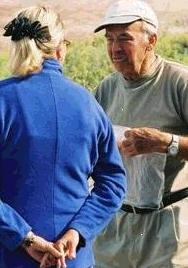
I wanted to talk with Joe, but he was gone the next day and we left the day after that (to catch the ferry to Guaymas). All I learned, through Dick, was that the old man lived in a nursing home somewhere and that one day he said to his companions there, “You can sit around. I’m going to Mexico.” They said, “You’re crazy.” He said, “Who cares? I’m gonna die any way.” And he drove off in his old sedan. That was a year ago, and this year he came back with an SUV.
Dick didn’t have a clue about his clam. He brought it around again, and it looked awful. It was squeezing out of its shell with little ventricles like a bad heart. “I put it in the water, and this happened,” the Walrus said.
Pat said later. “That was the death knell of the clam.” She said he had put it in fresh water.
Playing Hemingway
On our last night in Mexico we watched pelicans revealed in full, in their true nature as winged creatures. They had been a fixture in our whole month-long Baja travels, and I had come to think of them in terms of the old limerick:
“A funny bird is the pelican.
His mouth holds more than his belly can.
Da-da-da-dah
Da-da-da-dah (I forgot the middle lines)
I don’t see how in the hell he can.”
In all the bays and ports, pelicans were sitting around like old senators or or English Lords. They walked in a way that Pat can imitate. It’s all in the shoulders and the imperious facial expression and the webbed feet.
One morning at a beach on Bahia Concepcion a kayaker came in with some fish, which he began cleaning on the shore, drawing gulls and a committee of pelicans.
When he gestured as if to throw some fish guts, they moved as one, as only birds can, then settled back unanimously when they saw he didn’t deliver the goods. Soon the kayaker was directing them with his gestures, like an orchestra conductor. His buddies called him “the famous Baja choreographer.”

Often I would see them out in the bays doing what seemed from a distance to be clumsly belly-flops. They were, it seemed to me, gooneybirds: theoretically impossible, proof that evolution has a sense of humor.
Now, on our last night,we were in San Carlos (We had taken the ferry from Santa Rosalia to Guaymas). We were walking back to an RV park over a bridge at the resort when we saw several dozen pelicans fishing, full steam. It’s hard to describe something as clumsy-looking, with it’s overstated bill, flying over the waves with such grace.
But the really amazing thing was watching them suddenly go into free fall, wings spread beautifully and wide, bill first. They looked like suicide dives, except the birds, with perfect timing, tucked in just before they hit the water.
Then they would bob up and sit for 15 seconds, then raise their beaks. And each time we could see the sign of success: a streamlined lump going down a pelican gullet. They never missed.
Maybe it was the margaritas at Rosa’s Cantina, but we were really having fun watching the pelicans. We adjourned to Charlie’s Rock for another margarita with a view of the air show. It was like a World War II film: “Zero at three o’clock, Lt. Bush!” Blam-kablam!! Another enemy fighter goes down in the Pacfic.
I have to admit I even “shot” a few myself. It must be the Hemingway influence in Spanish-speaking port towns.
Now that I’ve seen him in full glory, I really love the pelican. It was a good send off to come to terms with him, although I still don’t know how in the hell he can. And my opinion of officious old senators has not changed.
Earlier that day we walked the 3-mile cove from San Carlos to the end of the beach and picked up interesting rocks and shells of all colors.
We said goodbye to some instant friends at the RV park early the next day and drove to the border, crossing by nightfall at booming Agua Prieta, Sonora, into dwindling Douglas, Ariz.
Old “Chaco,” my 1979 VW van, did 4,000 miles on the trip at less than the speed of trucks, buses and most cars on both sides of the border. The slow van bothered some yahoo American drivers (they would honk and swerve, close to clipping) but none in Mexico (where the roads are so narrow that childish behavior can get you killed).
Chaco was the smallest rig by far among the motor homes and fifth-wheelers and Class C units. People were curious but not surprised by the old VW. The most frequent comment by Americans and Canadians we met on the way was, “I used to have one of those.”
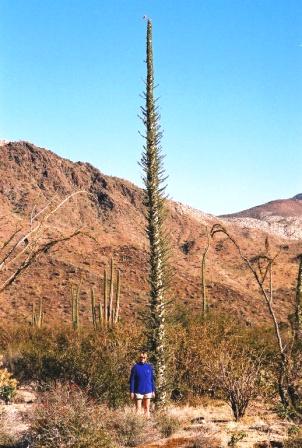
(Note: if comments don’t come up, hit the headline, pls.)

